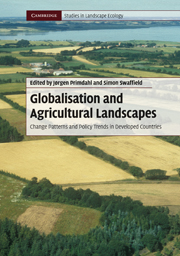Book contents
- Frontmatter
- Contents
- List of Contributors
- Preface
- 1 Globalisation and the sustainability of agricultural landscapes
- 2 Agricultural liberalisation, multifunctionality and the WTO: competing agendas for the future of farmed landscapes
- 3 Globalisation of agricultural landscapes: a land systems approach
- 4 Agricultural landscape changes through globalisation and biodiversity effects
- 5 Swiss agricultural policy reform: landscape changes in consequence of national agricultural policy and international competition pressure
- 6 Local landscape consequences of macro-scale policy reform: the New Zealand experiment
- 7 Rural landscape differentiation in the face of changing demands and policies: a typology of rural areas in Portugal
- 8 Globalisation and the local agricultural landscape: current change patterns and public policy interventions
- 9 From totalitarian to democratic landscapes: the transition in Estonia
- 10 Rural landscape change as a product of US federal policy
- 11 New approaches for urban–rural areas in Dutch spatial planning
- 12 Restoring agricultural landscapes in shrinking cities: re-inventing traditional concepts in Japanese planning
- 13 Globalisation and local agricultural landscapes: patterns of change, policy dilemmas and research questions
- Index
- References
6 - Local landscape consequences of macro-scale policy reform: the New Zealand experiment
Published online by Cambridge University Press: 05 June 2012
- Frontmatter
- Contents
- List of Contributors
- Preface
- 1 Globalisation and the sustainability of agricultural landscapes
- 2 Agricultural liberalisation, multifunctionality and the WTO: competing agendas for the future of farmed landscapes
- 3 Globalisation of agricultural landscapes: a land systems approach
- 4 Agricultural landscape changes through globalisation and biodiversity effects
- 5 Swiss agricultural policy reform: landscape changes in consequence of national agricultural policy and international competition pressure
- 6 Local landscape consequences of macro-scale policy reform: the New Zealand experiment
- 7 Rural landscape differentiation in the face of changing demands and policies: a typology of rural areas in Portugal
- 8 Globalisation and the local agricultural landscape: current change patterns and public policy interventions
- 9 From totalitarian to democratic landscapes: the transition in Estonia
- 10 Rural landscape change as a product of US federal policy
- 11 New approaches for urban–rural areas in Dutch spatial planning
- 12 Restoring agricultural landscapes in shrinking cities: re-inventing traditional concepts in Japanese planning
- 13 Globalisation and local agricultural landscapes: patterns of change, policy dilemmas and research questions
- Index
- References
Summary
Introduction
An unusual feature of New Zealand as a developed country is the role that rural landscapes continue to play in society and the economy. Rural activities have shaped New Zealand's identity and political economy for much of the twentieth century (Bell, 1996), and agriculture focused upon exports still comprises the largest single economic sector. Tourism is also a major source of foreign currency. Together, the primary and tourism sectors account for around 33% of gross domestic product (GDP), giving New Zealand the highest economic dependence upon environment in the OECD (Oram, 2007, p. 22). New Zealand products ranging from food, to clothing, to adventure tourism all use ideals of ‘clean and green’ to differentiate themselves in a global market. New Zealand has, in effect, established itself as a ‘brand state ’ (Van Ham, 2001) based upon its rural and wilderness landscapes.
A second distinctive feature which makes New Zealand of particular interest in a comparative study of globalisation and agricultural landscape change in developed countries is the way in which the political economy and its environmental management was reformed during the 1980s. New Zealand combined economic and trade liberalisation with a radical restructuring of the public sector, and the introduction of a new environmental policy and planning regime, based upon sustainable management of the environmental effects of land use. The New Zealand ‘experiment’ (Kelsey, 1995) has created unique planning and management challenges for agricultural landscapes, the outcomes of which are still being played out (Macleod and Moller, 2006).
- Type
- Chapter
- Information
- Globalisation and Agricultural LandscapesChange Patterns and Policy trends in Developed Countries, pp. 95 - 126Publisher: Cambridge University PressPrint publication year: 2010
References
- 1
- Cited by

